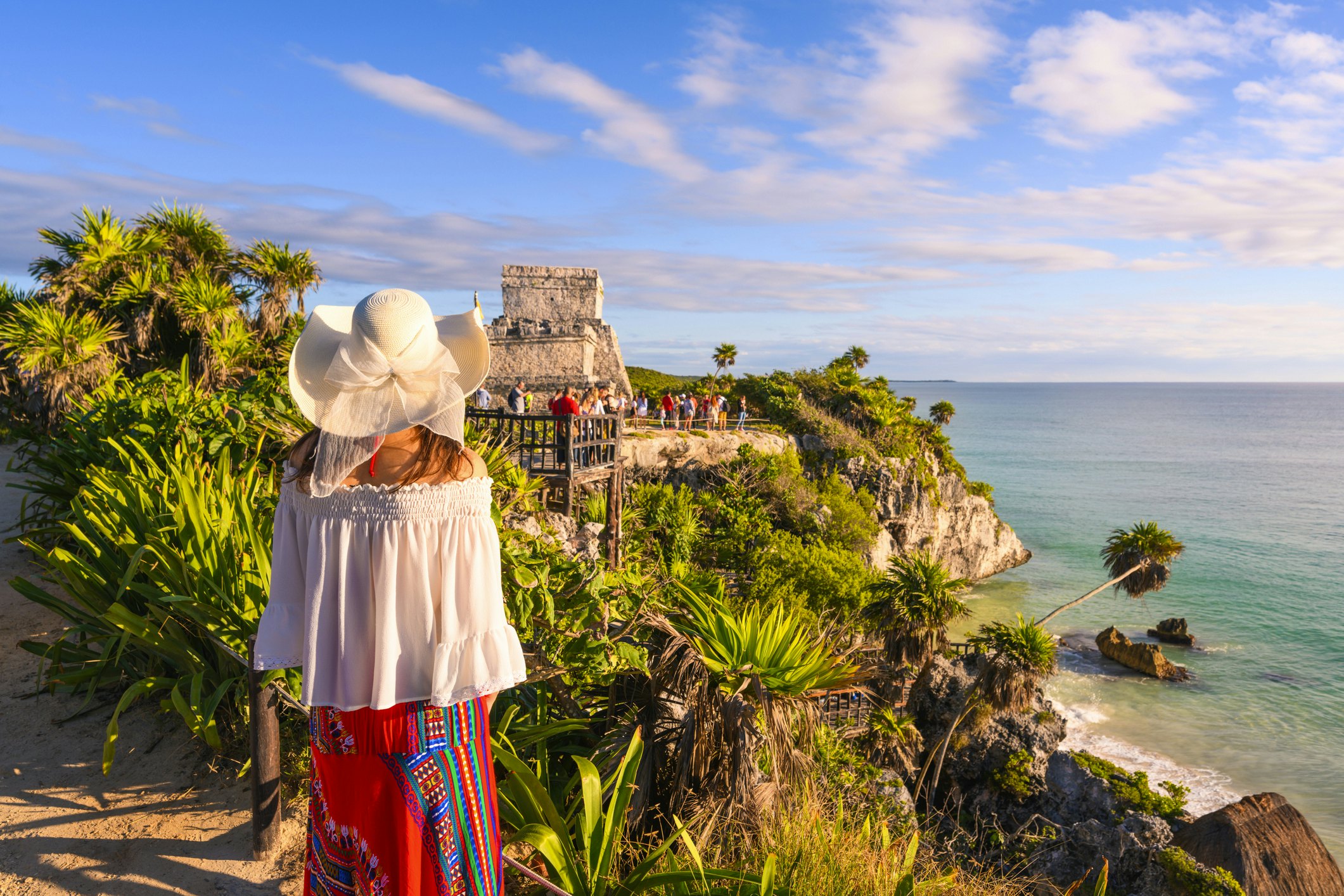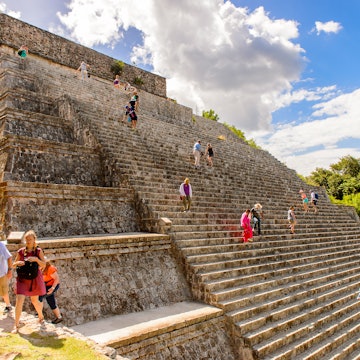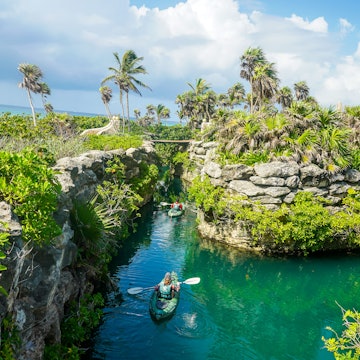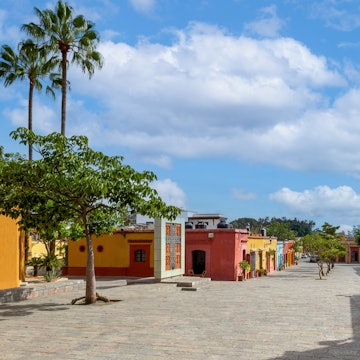
The 14 best things to do in Riviera Maya: ancient ruins, magical caverns and tree-top adventures

Feb 24, 2022 • 10 min read

The beautiful coast of the Riviera Maya makes it one of the most popular tourist destinations in Mexico © CampPhoto / iStock / Getty Images Plus
Extending across the northernmost tip of Mexico’s Yucatán Peninsula, the Riviera Maya is an 83-mile sweep of coastline running from the south of Cancún all the way to the Belize border.
The tourist corridor is a magnet for sun-seeking travelers with its powder-puff white sand beaches, legendary ruins, and the world’s second-largest coral reef. What makes the Riviera Maya all the more appealing is that it’s a year-round destination – although the best time to visit is between February and June when temperatures are mild and crowds thin out.
Beyond the sparkling strands, the Riviera Maya entices with an impressive lineup of well-preserved Maya ruins, world-class dive sites, and fun-filled cenotes (natural swimming holes). Let’s just say you won’t ever run out of things to do. But if you don’t know where to start, we’ve handpicked the best things to do in Riviera Maya – including both quintessential must-dos and unusual experiences for those who like to stray off the well-trodden trail.

1. Time travel at the Tulum ruins
Ranked high as one of the most prominent ruins in Mexico, Tulum is a great place to start your Riviera Maya journey. The Tulum ruins are perched on the top of rocky cliffs, high above the azure waters of the Caribbean – an uncommon location for an ancient Maya city. With evidence of habitation dating back as far as 564 CE, Tulum's heyday as a Maya city was in the 1200s and it has withstood the ravages of time and retained its grid-like layout, main structures, and a strong sense of history in every corner.
The compact archaeological site can be seen in a couple of hours; aim to get here before the tour groups arrive at 11 am and bring a swimsuit for a refreshing dip in the inviting water beneath the ruins. There is very little shade at the ruins and the opportunity to cool off in the sea is most welcome. Start with the waterfront temples and meander clockwise through the site – the real prize is the view that awaits along the cliff-edge trail of the Castillo, the tallest structure in Tulum, backed by cobalt waters and a spiny-tailed iguana or two.
2. Get a digital experience at Mystika Tulum
After exploring the Tulum ruins, make a stop at the new-age interactive digital museum, Mystika Tulum. It delivers a one-of-a-kind sensory experience designed to take you on a journey through the Maya cosmology through multi-sensorial rooms and installations. The venue is modest, and the entrance fee is higher than local museums, but it captures your imagination like no other, with outstanding visuals that both adults and kids will appreciate. This gallery is the brainchild of Pepe Soho, one of the most celebrated photographers in Mexico.
3. Float in the ancient Maya canals at Sian Ka’an
One of the most biodiverse places in the world, Reserva de la Biosfera de Sian Ka’an is a 1.3 million-acre reserve of mangroves, savannahs, spearmint lagoons, and virgin beaches. Just south of Tulum, this patch of wilderness is the largest protected area on Mexico’s Caribbean coast and an eco traveler’s dream come true. The majority of the Sian Ka’an is out-of-bounds, and only a fraction is designated for sustainable eco-tourism.
Sian Ka’an is best explored on a guided tour, as the rugged trails and waterways are challenging to traverse on your own. Maya-run Community Tours Sian Ka'an runs kayak tours through the lagoons and birdwatching tours that directly benefit the local community. While drifting down canals dug by the Mayas centuries earlier, try to spot giant land crabs and manatees, and listen out for howler monkeys.

4. Swim in a cavern
Underneath the lush jungles of the Yucatán Peninsula lies a secret underworld of turquoise pools and mystical caves. Cenotes were revered by the Mayan civilization and used as a portal to communicate with the gods. Today, you can see why these underground caverns played a pivotal role in the Maya world.
In the crisp mineral-rich water of Cenote Dos Ojos, you’ll get the chance to weave through narrow passages and swim between illuminated stalactites and stalagmites. What you’re seeing is just a fragment of the world's largest underwater cave systems – book a guided snorkeling tour run by the local Maya community or a scuba dive session if you’d like to venture deeper into the cave system.
The trio of cenotes near Playa del Carmen tends to receive fewer visitors: Azul, Cristalino, and Eden are all open-air cenotes with clear-as-glass water and skin-nibbling tropical fish darting around. They’re great for people of all ages – adventurous adults can dive off mini cliffs into the water, kids can wade in the shallow pools or meander along the jungle paths, and seniors have plenty of space for a picnic.
5. Step back in time at Punta Allen
Located at the end of the Boca Paila Peninsula, the remote fishing village of Punta Allen gives a glimpse of how the Riviera Maya used to be. The picture-perfect beaches are empty except for a few stray dogs and a fisherman or two. A sandy main drag cuts through the sleepy pueblo, lined by crumbling wooden houses, simple loncherias (eateries), and grocery stores.
Getting here is not easy: even though it’s just 25 miles (40km) from the Sian Ka'an entrance, most people take at least two hours to traverse the bumpy dirt track to Punta Allen. But the village is well worth the arduous journey for its low-key atmosphere, traffic-free tranquility, and absence of mass tourism.
Rise early for a dolphin-watching trip or go snorkeling over the technicolored reef. After that, join the village's seniors on a fishing trip, and end the night under the starry skies in a bell tent at Hotel Cielo y Selva.
6. Swim in the magic waters of Laguna Bacalar
For those keen on veering off the beaten path, we’ll let you in on a secret: Laguna Bacalar is a quiet, little-known lake close to the border of Belize, with inviting spearmint water, stromatolite-rimmed shores, and overwater hammocks. Nicknamed Laguna de Siete Colores (lagoon of seven colors), the water alternates between light turquoise and dark indigo.
To explore the lagoon, base yourself in Bacalar town, just two hours from Tulum by car. The village appeals more to indie travelers than the average package tourist, with a surprisingly good selection of contemporary cafes and food trucks. Rent a kayak or join a boat tour to see the 38-mile-long (60km) stretch of water, making stops at the Canal de los Piratas, a channel that used to be plundered by pirates, and Cenote Cristalino, fringed by ancient pancake-like rocks known as stromatolites.
7. Watch the sunrise on a SUP
There’s no better time to take to the waters of the Riviera Maya than at sunrise. At this golden hour, the water is as smooth as glass, and the beach is empty save for a few other early birds. The usual raucous atmosphere of Playa del Carmen is gone, and in its place is a soothing silence punctuated by the sound of lapping waves and the squawks of seagulls overhead.
Paddleboarding at sunrise is an extraordinary experience, even for SUP (stand-up paddleboard) enthusiasts. Aloha Paddle Club organizes guided sunrise SUP sessions daily at Inti Beach, in the center of Playa del Carmen. Book in advance as these sessions are popular.

8. Snorkel with turtles in Akumal
Akumal is no longer a secret, but its swimmable lagoon remains the best place to snorkel with turtles in the Riviera Maya. The U-shaped bay and seagrass draw in turtles by the droves, with the coral reef protecting everything inside the bay. Because of the reef, the water here is always clear and calm – perfect conditions for snorkeling. If you’re lucky, you might even spot the elusive eagle ray swimming in the seagrass meadow.
To swim in the protected marine reserve, joining a guided snorkeling tour is mandatory. Snorkeling gear and life safety vests are included. Those with young kids can also sign up for a snorkel excursion and marine biology class here with We Love the Sea.
9. Fly over the jungles
Active travelers rejoice: the Ruta de Cenotes, just 30 minutes south of Cancún, is a vast expanse of tropical forest that plays host to several eco-adventure parks. These joints, complete with zip line circuits, jungle trails, and cenotes, promise adults and children alike a thrilling good time – with all the safety measures in place.
Selvática is outfitted with 10 different zip lines, flying fox circuits, and even a bungee swing. You can also choose to hop on an ATV (all-terrain vehicle) or a 4x4 buggy and trundle through the bush, though kids under 8 are not allowed on them for safety reasons. Cenotes Zapote is home to four different cenotes - including one with prehistoric sloth fossils. Each is equipped with its own zip line that whisk you through the wilderness.
10. Learn to surf at Puerto Aventuras
Puerto Aventuras is one of the best surfing beaches in the Riviera Maya, thanks to the perfect swells and water conditions. The beach is protected by seawalls, in a natural curve away from the open ocean.
Book yourself and your kids on fun, interactive lessons run by Nohoch Surf School. Their mini surf camps get raving reviews from little ones aged 4 to 12. If you’re already a surfer, the school has an excellent selection of boards that you can rent.
11. Explore Isla Cozumel on a Jeep
Across the bay from Playa del Carmen, Isla Cozumel makes for an easy island escape with its low-key atmosphere and rugged, empty beaches. The best way to explore the 30-mile (48 km) long island is to hire a jeep or buggy as most of the island is covered by lush tropical forests, nature reserves, and empty beaches.
Head straight to the Punta Sur Ecological Park at the southern tip of the island – this natural reserve sprawls across 2500 acres of lagoon systems, tropical rainforests, and wild beaches. See the Maya ruin El Caracol, cruise the saltwater lagoon and spot crocodiles, then climb the 133 steps onto the top of the Celarain Lighthouse.
12. Get artsy in SFER IK
A contemporary art museum constructed mainly out of bejuco (an endemic wood that resembles vine), SFER IK (pronounced spheric) is a work of art in itself. Built using traditional techniques by Maya artisans, the structure was designed to blend in perfectly with the lush jungles of Tulum.
Wander barefoot through the curving corridor and bridges made of twisted vine-like wood and admire the permanent art collection created by renowned artists such as Ernesto Neto and Artur Lescher. Circular windows open out to the dense tropical forest surrounding you, with the sound of the waves in the not-so-far distance – this spot truly showcases how nature and art intertwine in the Riviera Maya.
13. Cleanse your soul at a temazcal
The Riviera Maya may have developed rapidly over the past decades due to tourism – but its rich Maya culture and traditions remain. An interesting Maya ritual that’s still practiced today is the temazcal, a pre-Colombian purification ceremony believed to cleanse your soul and rid you of illnesses.
A Maya leader leads the rite, guiding you into a dome-shaped sweat house fired up by steaming volcanic rocks, before beating you with corn husks. In the boiling heat, it’s hardly a relaxing experience, but keep your cool and you might just leave rejuvenated and balanced. Yaax Healing Sanctuary runs temazcal ceremonies at full moon led by a Maya healer.
14. Sign up for a Maya cooking class
Take a crash course in Maya ancestral cuisine and experience a side of the Riviera Maya that few are familiar with. When you book a cooking class with a local Maya family, you’ll get to know them, take a peek into their lives, and learn all about Maya ingredients, traditional dishes, and cooking methods.
Maya Immersion gives you a chance to do just that: from tasting the achiote spice to making massa (corn paste) from scratch and wrapping your own tamales. You’ll discover a cuisine distinctive from the Yucatecan or Mexican culinary world we know.
You may also like:
How to get around in Riviera Maya
A guide to Playa del Carmen for digital nomads
Where to find cenotes – Mexico's amazing natural swimming holes















